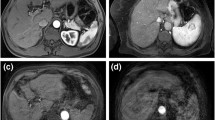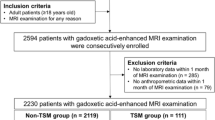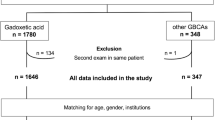Abstract
Aims
To evaluate motion artifacts, breath-hold failure, acute transient dyspnea, and clinical parameters during hepatic arterial phase of gadoxetate disodium-enhanced magnetic resonance (MR) imaging.
Methods
This was an institutional review board-approved observational prospective study (written informed consent acquired) performed in 250 consecutive patients, who underwent liver MR with a multiarterial phase technique. Oxygen saturation (SatO2) and heart rate (HR) were monitored, while patients reported subjective symptoms. Breath-holds were assessed using prospective acquisition correction technique (PACE) monitors. Three readers independently analyzed all images to establish the presence of motion artifacts. Nonparametric statistical testing and Fleiss’ kappa were used.
Results
No statistical differences in SatO2 and HR values were observed during the entire length of MR examination. The PACE graphs showed an altered breath-hold in 16/250 patients (6.4%), however only 6 patients self-reported symptoms during the procedure, and among these 6 subjects, only 2 suffered from acute transient dyspnea (0.8%). Motion-related artifacts increased mostly in the third arterial phase of gadoxetate disodium acquisition (p < 0.0001): The artifacts incidence was 2.9% in the first phase; 4.0% in the second; and 19.5% in the third. This increase was mainly due to patients’ inability to hold their breath for the entire duration of the examination. However, at least one gadoxetate disodium arterial phase without motion artifacts and adequate for acquisition timing, was acquired in all MR examinations.
Conclusion
The incidence of breath-hold failure and acute transient dyspnea after gadoxetate disodium administration increased during the third arterial phase only. Our protocol allowed the acquisition of at least one arterial phase not compromised by motion artifacts and adequate for acquisition timing, in all patients.



Similar content being viewed by others
References
Bruix J, Reig M, Sherman M (2016) Evidence-based diagnosis, staging, and treatment of patients with hepatocellular carcinoma. Gastroenterology 150(4):835–853
Neri E, Bali MA, Ba-Ssalamah A et al (2016) ESGAR consensus statement on liver MR imaging and clinical use of liver-specific contrast agents. Eur Radiol 26(4):921–931
Kazmierczak PM, Theisen D, Thierfelder KM et al (2015) Improved detection of hypervascular liver lesions with CAIPIRINHA-Dixon-TWIST-volume-interpolated breath-hold examination. Invest Radiol 50(3):153–160
Frydrychowicz A, Lubner MG, Brown JJ et al (2012) Hepatobiliary MR imaging with gadolinium-based contrast agents. J Magn Reson Imaging JMRI 35(3):492–511
Davenport MS, Viglianti BL, Al-Hawary MM et al (2013) Comparison of acute transient dyspnea after intravenous administration of gadoxetate disodium and gadobenate dimeglumine: effect on arterial phase image quality. Radiology 266(2):452–461
Pietryga JA, Burke LM, Marin D, Jaffe TA, Bashir MR (2014) Respiratory motion artifact affecting hepatic arterial phase imaging with gadoxetate disodium: examination recovery with a multiple arterial phase acquisition. Radiology 271(2):426–434
Yoo JL, Lee CH, Park YS et al (2016) The short breath-hold technique, controlled aliasing in parallel imaging results in higher acceleration, can be the first step to overcoming a degraded hepatic arterial phase in liver magnetic resonance imaging: a prospective randomized control study. Invest Radiol 51(7):440–446
Kim SY, Park SH, Wu EH et al (2015) Transient respiratory motion artifact during arterial phase MRI with gadoxetate disodium: risk factor analyses. AJR Am J Roentgenol 204(6):1220–1227
Davenport MS, Bashir MR, Pietryga JA, Weber JT, Khalatbari S, Hussain HK (2014) Dose–toxicity relationship of gadoxetate disodium and transient severe respiratory motion artifact. AJR Am J Roentgenol 203(4):796–802
Bashir MR, Castelli P, Davenport MS et al (2015) Respiratory motion artifact affecting hepatic arterial phase MR imaging with gadoxetate disodium is more common in patients with a prior episode of arterial phase motion associated with gadoxetate disodium. Radiology 274(1):141–148
Motosugi U, Bannas P, Bookwalter CA, Sano K, Reeder SB (2016) An investigation of transient severe motion related to gadoxetic acid-enhanced MR imaging. Radiology 279(1):93–102
Haradome H, Grazioli L, Tsunoo M et al (2010) Can MR fluoroscopic triggering technique and slow rate injection provide appropriate arterial phase images with reducing artifacts on gadoxetic acid-DTPA (Gd-EOB-DTPA)-enhanced hepatic MR imaging? J Magn Reson Imaging JMRI 32(2):334–340
Luetkens JA, Kupczyk PA, Doerner J et al (2015) Respiratory motion artefacts in dynamic liver MRI: a comparison using gadoxetate disodium and gadobutrol. Eur Radiol 25(11):3207–3213
Gutzeit A, Matoori S, Froehlich J, Koh D (2016) Reduction in respiratory motion artifacts on gadoxetate acid-enhanced MR images after training technicians. Radiology 279(3):981–982
Kim YK, Lin WC, Sung K et al (2017) Reducing artifacts during arterial phase of gadoxetate disodium-enhanced MR imaging: dilution method versus reduced injection rate. Radiology 283(2):429–437
Kim YK, Lin WC, Sung K et al (2017) Reducing artifacts during arterial phase of gadoxetate disodium-enhanced MR imaging: dilution method versus reduced injection rate. Radiology 283(2):429–437
McClellan TR, Motosugi U, Middleton MS et al (2017) Intravenous gadoxetate disodium administration reduces breath-holding capacity in the hepatic arterial phase: a multi-center randomized placebo-controlled trial. Radiology 282(2):361–368
Ogawa M, Kawai T, Kan H et al (2015) Shortened breath-hold contrast-enhanced MRI of the liver using a new parallel imaging technique, CAIPIRINHA (controlled aliasing in parallel imaging results in higher acceleration): a comparison with conventional GRAPPA technique. Abdom Imaging 40(8):3091–3098
Albrecht MH, Bodelle B, Varga-Szemes A et al (2017) Intra-individual comparison of CAIPIRINHA VIBE technique with conventional VIBE sequences in contrast-enhanced MRI of focal liver lesions. Eur J Radiol 86:20–25
Hayashi T, Saitoh S, Tsuji Y et al (2015) Influence of gadoxetate disodium on oxygen saturation and heart rate during dynamic contrast-enhanced MR imaging. Radiology 276(3):756–765
Motosugi U (2015) Gadoxetic acid-induced acute transient dyspnea: the perspective of Japanese radiologists. Magn Reson Med Sci MRMS Off J Jpn Soc Magn Reson Med 14(2):163–164
Davenport MS, Caoili EM, Kaza RK, Hussain HK (2014) Matched within-patient cohort study of transient arterial phase respiratory motion-related artifact in MR imaging of the liver: gadoxetate disodium versus gadobenate dimeglumine. Radiology 272(1):123–131
Acknowledgements
Authors would like to thank Dr Sara Cortinovis for her invaluable scientific advice and organizational support and Dr Daniela Cigognini for her medical writing support.
Author information
Authors and Affiliations
Corresponding author
Ethics declarations
Conflict of interest
All authors declare that they have no conflicts.
Ethical standard
All procedures performed in studies involving human participants were in accordance with the ethical standards of the institutional and/or national research committee and with the 1964 Helsinki Declaration and its later amendments or comparable ethical standards.
Informed consent
Informed consent was obtained from all individual participants included in the study.
Rights and permissions
About this article
Cite this article
Grazioli, L., Faletti, R., Frittoli, B. et al. Evaluation of incidence of acute transient dyspnea and related artifacts after administration of gadoxetate disodium: a prospective observational study. Radiol med 123, 910–917 (2018). https://doi.org/10.1007/s11547-018-0927-y
Received:
Accepted:
Published:
Issue Date:
DOI: https://doi.org/10.1007/s11547-018-0927-y




